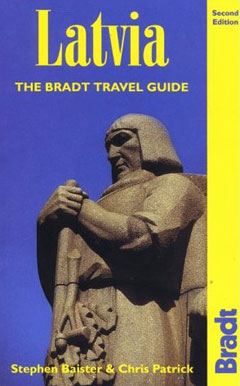
Recently a superb recording has come out featuring Latvian folk music played on bagpipes. The album, Dūdas Latvijā (Bagpipes in Latvia) sports a picture of a young, bagpiping lad in the arch of castle ruins. It is an excellent compilation of Latvian songs ranging from majestic, energetic and uplifting music to matter-of-fact and haunting pieces. This album is the most recent addition to UPE Recording Co.‘s Latvian Folk Music Collection and is a welcome one. While some may complain that there are no English translations of the songs, something better rewards the reader. It is a wonderful essay, written by world-class ethnomusicologist Valdis Muktupāvels, explaining about bagpipes in Latvia.
Bagpipes always have their majestic appeal; some like them more than others. This fact holds true to the chagrin of bagpipers’ neighbors. Referring to its loudness, one bagpiping enthusiast bluntly put it, “How else can you have something as loud as an electric guitar but with no cord?” Having won an international audience with younger audiences with such groups as Dead Can Dance, this instrument hides its long folk history in Latvia. What has been forgotten is that large numbers of festive bagpipers would congregate, playing through the night on the hills and shores of Latvia
Since this long bagpipe tradition has a vivacious presence still found in Latvia, Dūdas Latvijā is an album that conveys many moods. Near the beginning there’s a nice beer-drinking song with warm-hearted camaraderie, “Alus dziesma” (the Beer song) sung by Vidvuds Mednis and friends. Midway in through this song are some interesting refrains, sounding like the chanting and singing found in American Indian pow-wows. Later music in the album, like in the selections “Vaidi” (performed by Valdis and Māris Muktupāvels) and “Dūdu sauciens” (played by Rasa) transports the listener to other eras. A slow version of “Garais dancis” (Long dance) evokes a stately and majestic promenade of kings and queens. The whole album creates a feeling of movement and energy even in its tenderest, quietest movements, as in the song “Mildas dziesma” sung by Iļģi.
One foggy night in Old Rīga I walked home, having helped close a bar. Snow silently had fallen a few hours earlier and the air had warmed up again, bringing together in springtime a rare snow and fog. Both snow and fog were catching light and creating a soft omnipresent glow. It was in muffled, foggy, early morning air that I first heard the haunting, beautiful sound of bagpipes in Rīga. Two bagpipers, with what I later learned were bagpipes common to Central Europe, played at the base of “Milda,” or the Freedom Monument. They played as a slightly amused police officer and I watched. I could only stand in amazement and observe in admiration. After blurting out how I always wanted to learn the bagpipes, the players gladly introduced me to a third set of bagpipes. It was magical. Consequently I have learned enough about bagpipes to deeply appreciate this smaller cousin of the Scottish bagpipes. I easily hear when bagpipes are used, even in the most unexpected and delicate of songs like “Mildas dziesma” (Milda’s Song) Eventually, I got my own bagpipes and am now trying to slowly relearn music. With that, I should be considered a biased judge in rating this album, but a discerning one all the same.
So, what awaits the audiophile who listens to the whole collection?
Much! One song, “Pīmiņ, brōļ’” near the end of the album impressed me with its brotherly love, sung in the Latgalian dialect. The piece played by Rasa, “Aiz Daugavas vara dārzs,”; at first sounds like medieval music brilliantly coming alive and it then carries through with a delightful melody that can happily stick in one’s ear. Towards the end of the CD there is a collection of songs that convey a type of sentiment and emotion that only bagpipes can, a contemplative, yet fierce awareness. In the beginning there’s a playful, carnival, festive feel heard in “Dūdu sauciens.” A summer ball held in the fields with its own homespun music is conjured up from “Dūdu balss un zaglis” (Bagpipes’ Voice and Thief). The hypnotic song “Dūdas balss” (The voice of the bagpipe ), played by Grodi, feels mysterious and seems almost Arabic. It could be like what one might hear for the music inside a sheik’s tent where he was being served his pleasure. Contrasting that song’s sultry feel, we hear a cheerful chorus sing in “Ai, dū makaidū.”
Bagpipes can voice a heavy, foreboding and ponderous message that can put off some people. Yet bagpiping can vary and create expressions of joy, beauty, freedom and wildness. Dūdas Latvijā does this. The songs on this album create a warm, energetic air, good for a gathering of friends. While heard at keg parties or at funerals or at parades, the best bagpipe music is what you can play at home and with friends. This album does this and so much more. Dūdas Latvijā gets a “two thumbs up” in my judgment.
Details
Dūdas Latvijā
Latviešu tautas mūzikas kolekcija
UPE Recording Co., 2000
UPE CD 017




